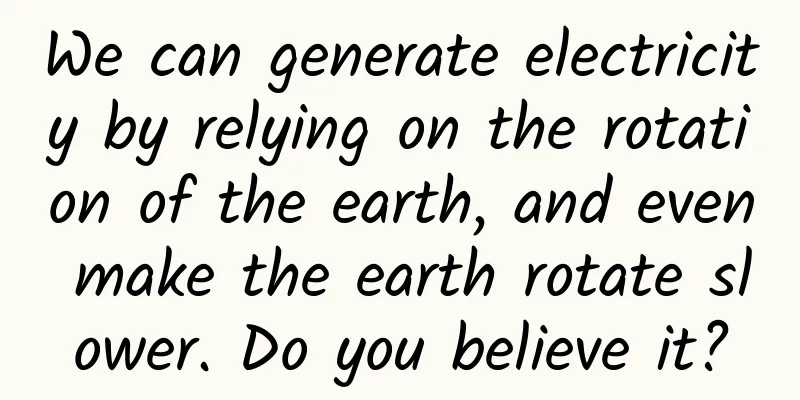We can generate electricity by relying on the rotation of the earth, and even make the earth rotate slower. Do you believe it?

|
Physicists have come up with an innovative idea - the energy from the Earth's rotation through its own magnetic field can be used to generate electricity. Experiments have shown that a special magnetic material can help harness the energy generated by the Earth's rotation. But not everyone is convinced. The relevant research results were published in Physical Review Research on March 19 and presented at a meeting of the American Physical Society. The researchers say the finding is intriguing, if controversial. The effect has only been identified in a carefully designed device, and produced just 17 microvolts -- a tiny fraction of the voltage released when a single neuron fires, making it difficult to confirm whether the observation is due to other effects. If it is real, and the device can be scaled up, it could generate zero-emission electricity while remaining stationary, which could be useful in remote areas or for medical applications. Copyrighted stock images, reprinting may cause copyright disputes "This idea is somewhat counterintuitive and has been controversial since Faraday's time," said Paul Thomas, a physicist emeritus at the University of Wisconsin-Eau Claire. But he believes the experiment, led by physicist Christopher Chyba of Princeton University, was very careful. "I think it's convincing and remarkable." Others also think the results are shocking, but remain skeptical. Rinke Wijngaarden, a retired physicist who worked at the Free University of Amsterdam in the Netherlands, began to pay attention to the authors' claims in 2016 and did not find the effect in his own experiments in 2018. He thinks the work is very interesting, but remains convinced that "the theory of Chyba et al. cannot be correct." In theory, the device works like a power station, where a conductor passing through a magnetic field causes electrons to move, thus generating an electric current. According to a 1912 demonstration, as the Earth rotates, parts of the magnetic field remain stationary, and conductors on the Earth's surface will pass through certain parts of the magnetic field. Normally, this wouldn't generate an electric current because in a uniform magnetic field like Earth's, the electrons feeling that push would rearrange themselves, creating an opposing electric force that would ultimately keep the charges stationary. But Chyba and his colleagues say they have found a loophole. Using complex calculations, the researchers showed that certain materials with special properties, when formed into round tubes, can direct the Earth's magnetic field into a strange configuration. They believe this will generate a magnetic push that cannot be counteracted by the electrostatic forces inside the device, thus generating an electric current. To prove their theory, the researchers made a hollow cylinder out of a soft magnetic material containing manganese, zinc and iron. While controlling for other effects, they looked for the voltage and current through the device. They observed a voltage of 17 microvolts, depending on the orientation of the device relative to the Earth's magnetic field. When they used a solid conductor instead of a hollow tube, the voltage was zero. “The observed voltage could be so small due to many other factors.” But Wijngaarden says the Chyba team “went to great lengths to try to avoid” other possible influences, such as temperature changes. Wijngaarden says more evidence is needed before concluding that the voltage is indeed coming from the Earth's rotation. Physicists could test whether the experiment would produce different results at different latitudes, as predicted. Even if successful, this approach wouldn't create energy out of thin air. It would harness the Earth's kinetic energy and, in the process, cause the planet's rotation to gradually slow down -- albeit only slightly. If this technology met all of the planet's electricity needs, which in 2022 would be about 11 terawatts, the authors calculate that it would slow the planet's rotation by 7 milliseconds over the next century. References [1]https://doi.org/10.1103/PhysRevResearch.7.013285 Planning and production Source: China Science Daily Editor: Yinuo Proofread by Xu Lailinlin |
>>: These 3 types of toothpaste are included in the "blacklist", do you have any at home?
Recommend
E-commerce is rampant in the circle of friends: This is not the way to make money from acquaintances
The debate about WeChat business is getting more ...
Complete list of product promotion channels in 2019!
Many advertisers will ask what channels are avail...
User operations, how to solve user pain points?
When considering user needs, we look at the produ...
Planning activities: 4 efficient promotion methods
This time, the editor would like to share with yo...
Android decompilation - smali syntax
Preface We have talked about the tools for androi...
How much does it cost to customize a large turntable mini program in Huangshan?
How much does it cost to customize the Huangshan ...
Good news for independent developers: a complete collection of development tools
[[144035]] A foreign website "All Dev Resour...
All questions and solutions for App Store listing
1. How much does it cost to list an app on the ap...
Will Android 8.0, which is said to be the smoothest version in history, help the mobile phone industry counterattack iPhone?
In recent years, the competition among smartphone...
100 fissions summarize these 3 user growth rules!
With the "Announcement on the Handling of In...
praise! An inventory of creative cases in 6 major industries for information flow advertising!
During my years as a bidder, I asked myself more ...
How to promote App channels effectively? 3 stages!
APP channel promotion needs to go through three s...
Product Operation: What should I do if DAU decreases?
This article would like to use a case of data dec...
What are the specific hot topics in the proposals for the 2022 Two Sessions? Let’s take a look and see if there is anything you are interested in?
In recent days, I believe many of you have seen t...

![[Live] Aihui Lu from Zego Technology: How to use Zego SDK to instantly build a real-time voice and video APP](/upload/images/67ebd739c2abb.webp)







